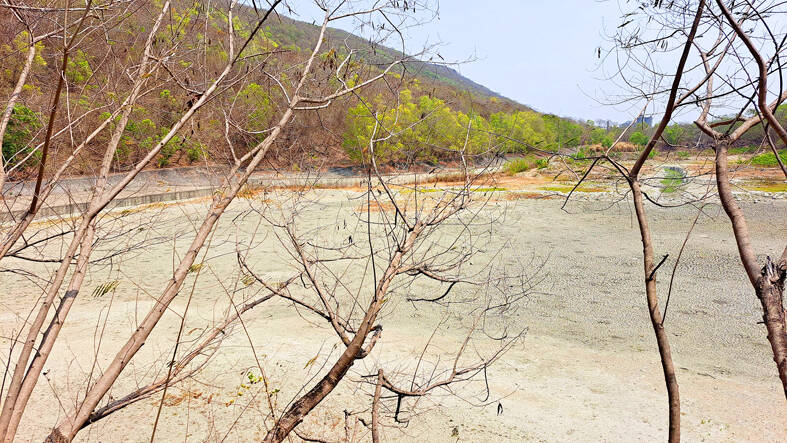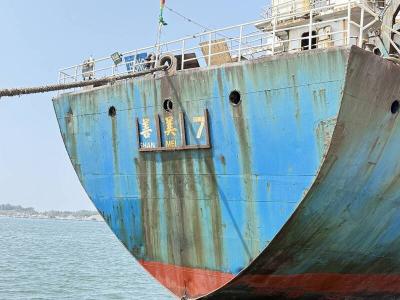The Central Weather Administration (CWA) said it is recalibrating its drought monitoring and early warning system to provide better early warnings to water management and agricultural agencies, after looking at data from three significant droughts Taiwan has experienced since 2000.
Taiwan’s regions are affected by drought differently, data from the National Science and Technology Center for Disaster Reduction’s Climate Change Disaster Risk Assessment Web site showed.
For example, when comparing the ratios of total precipitation between wet and dry seasons across the nation, the disparity is greater in southern Taiwan, so the risk of drought occurring in southern Taiwan is greater than in northern Taiwan.

Photo: CNA
There have been three severe droughts in Taiwan since 2000: one from 2002 to 2004, another from 2015 to 2016, and the last from 2020 to 2021, CWA climate forecasting division head Lo Tzu-ting (羅資婷) said.
Droughts are mainly caused by a lack of precipitation over an extended period, but there could be multiple causes, Lo said, adding that although the three severe droughts affected the whole nation, the severity varied depending on the region.
During the drought between 2020 and 2021, Taiwan had low rainfall due to strong North Pacific High pressure anomalies brought by La Nina. There were no typhoons during that period and the drought was more severe in central and southern Taiwan, Lo said.
Meanwhile, the severe drought from 2002 to 2004, which was not influenced by La Nina, was more serious in central and northern Taiwan, she said.
Rainfall across different regions was relatively low from October 2001 to June 2002, CWA data showed.
In addition to low total precipitation, the number of days with rainfall was also low, especially during the winter and spring seasons, with rainy days dropping to about one-third to one-half of the average number of rainy days for those seasons, the data showed.
In 2014, there was low precipitation during the wet seasons, causing a rare, major drought in Central Taiwan in 2015, which led to taxes being levied on heavy water users, the Water Resources Agency’s data showed.
There are several weather forecast models and drought indexes developed by different meteorological organizations and academics.
Taiwan uses the Standardized Precipitation Index (SPI) and Standardized Precipitation Evapotranspiration Index (SPEI) as meteorological drought indicators, Lo said.
The SPI characterizes droughts in different timescales, such as three months, six months or two years, while the SPEI measures drought severity according to its intensity and duration, and identify the onset and end of drought periods, she said.
Lo said the CWA is developing and recalibrating its drought monitoring and early warning system based on the SPI and the SPEI, which is expected to take about a year.
The improved drought warnings would first be provided to water management and agricultural agencies to help them prepare in advance, Lo added.

An undersea cable to Penghu County has been severed, the Ministry of Digital Affairs said today, with a Chinese-funded ship suspected of being responsible. It comes just a month after a Chinese ship was suspected of severing an undersea cable north of Keelung Harbor. The National Communications and Cyber Security Center received a report at 3:03am today from Chunghwa Telecom that the No. 3 cable from Taiwan to Penghu was severed 14.7km off the coast of Tainan, the Ministry of Digital Affairs said. The Coast Guard Administration (CGA) upon receiving a report from Chunghwa Telecom began to monitor the Togolese-flagged Hong Tai (宏泰)

A cat named Mikan (蜜柑) has brought in revenue of more than NT$10 million (US$305,390) for the Kaohsiung MRT last year. Mikan, born on April 4, 2020, was a stray cat before being adopted by personnel of Kaohsiung MRT’s Ciaotou Sugar Refinery Station. Mikan was named after a Japanese term for mandarin orange due to his color and because he looks like an orange when curled up. He was named “station master” of Ciaotou Sugar Refinery Station in September 2020, and has since become famous. With Kaohsiung MRT’s branding, along with the release of a set of cultural and creative products, station master Mikan

RISING TOURISM: A survey showed that tourist visits increased by 35 percent last year, while newly created attractions contributed almost half of the growth Changhua County’s Lukang Old Street (鹿港老街) and its surrounding historical area clinched first place among Taiwan’s most successful tourist attractions last year, while no location in eastern Taiwan achieved a spot in the top 20 list, the Tourism Administration said. The listing was created by the Tourism Administration’s Forward-looking Tourism Policy Research office. Last year, the Lukang Old Street and its surrounding area had 17.3 million visitors, more than the 16 million visitors for the Wenhua Road Night Market (文化路夜市) in Chiayi City and 14.5 million visitors at Tainan’s Anping (安平) historical area, it said. The Taipei 101 skyscraper and its environs —

Taiwan on Friday said a New Zealand hamburger restaurant has apologized for a racist remark to a Taiwanese customer after reports that it had first apologized to China sparked outrage in Taiwan. An image posted on Threads by a Taiwanese who ate at Fergburger in Queenstown showed that their receipt dated Sunday last week included the words “Ching Chang,” a racial slur. The Chinese Consulate-General in Christchurch in a statement on Thursday said it had received and accepted an apology from the restaurant over the incident. The comment triggered an online furor among Taiwanese who saw it as an insult to the